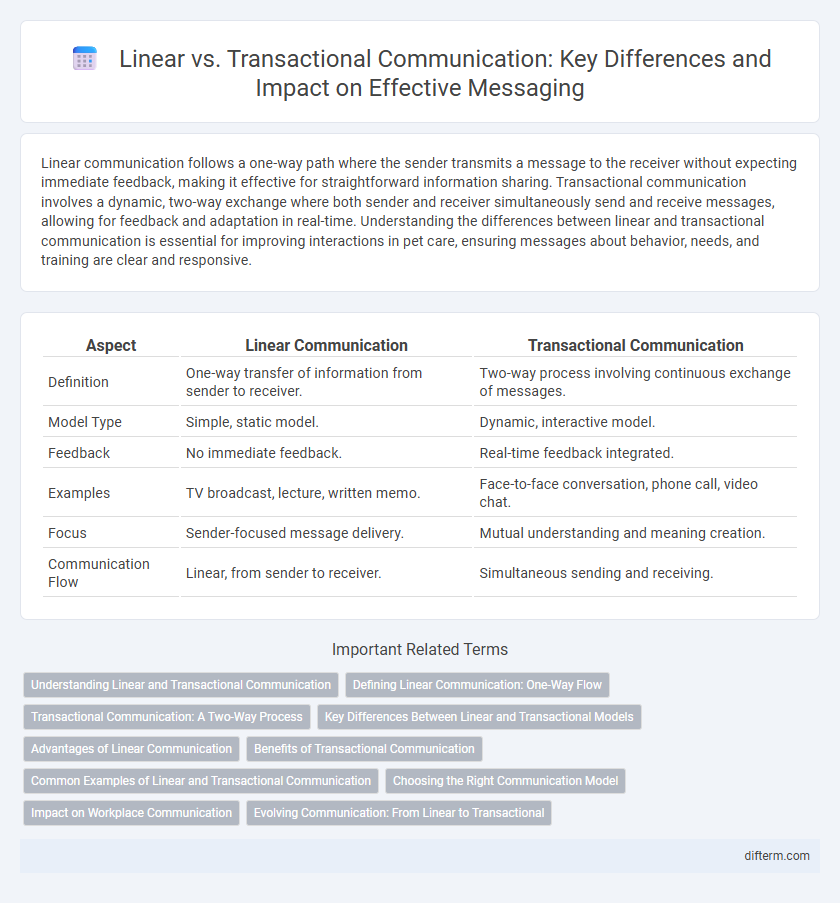Linear communication follows a one-way path where the sender transmits a message to the receiver without expecting immediate feedback, making it effective for straightforward information sharing. Transactional communication involves a dynamic, two-way exchange where both sender and receiver simultaneously send and receive messages, allowing for feedback and adaptation in real-time. Understanding the differences between linear and transactional communication is essential for improving interactions in pet care, ensuring messages about behavior, needs, and training are clear and responsive.
Table of Comparison
| Aspect | Linear Communication | Transactional Communication |
|---|---|---|
| Definition | One-way transfer of information from sender to receiver. | Two-way process involving continuous exchange of messages. |
| Model Type | Simple, static model. | Dynamic, interactive model. |
| Feedback | No immediate feedback. | Real-time feedback integrated. |
| Examples | TV broadcast, lecture, written memo. | Face-to-face conversation, phone call, video chat. |
| Focus | Sender-focused message delivery. | Mutual understanding and meaning creation. |
| Communication Flow | Linear, from sender to receiver. | Simultaneous sending and receiving. |
Understanding Linear and Transactional Communication
Linear communication is a one-way process where the sender transmits a message directly to the receiver without feedback, emphasizing clarity and straightforward delivery. Transactional communication involves simultaneous sending and receiving of messages, highlighting interaction, feedback, and context to create shared meaning. Understanding these models enhances effective communication by recognizing when direct messaging or interactive dialogue is most appropriate.
Defining Linear Communication: One-Way Flow
Linear communication involves a one-way flow of information where a sender transmits a message directly to a receiver without feedback or interaction. This model emphasizes clear, concise delivery but limits response opportunities, making it effective for simple or urgent messages. Examples include public speeches, broadcasts, and instructional materials where immediate dialogue is unnecessary.
Transactional Communication: A Two-Way Process
Transactional communication involves a dynamic, two-way exchange where both sender and receiver simultaneously influence the conversation, fostering immediate feedback and adaptation. This continuous interaction enhances understanding and reduces misinterpretations by accounting for context, emotions, and nonverbal cues. Unlike linear communication, transactional models emphasize the collaborative construction of meaning in real time.
Key Differences Between Linear and Transactional Models
Linear communication models emphasize a one-way flow of information from sender to receiver, focusing on message transmission without feedback loops. Transactional models incorporate simultaneous, dynamic exchanges where sender and receiver roles continuously shift, allowing real-time feedback and adaptation. The transactional approach highlights context, noise, and nonverbal cues, making it more representative of complex human interactions.
Advantages of Linear Communication
Linear communication offers clear and straightforward message delivery, reducing the chances of misunderstanding. It ensures efficient one-way information flow, ideal for announcements and instructions where immediate feedback is not necessary. This model enhances message control and consistency, making it effective in formal settings.
Benefits of Transactional Communication
Transactional communication enhances real-time feedback, fostering more effective and dynamic exchanges between participants. This model supports simultaneous sending and receiving of messages, allowing for immediate clarification and deeper understanding. It improves relationship building by enabling adaptive responses based on emotional and contextual cues.
Common Examples of Linear and Transactional Communication
Linear communication often occurs in scenarios like public speeches, television broadcasts, and written memos where messages travel in one direction without immediate feedback. Transactional communication is common in face-to-face conversations, phone calls, and video conferences, involving simultaneous sending and receiving of messages with real-time feedback. Both models highlight different dynamics in how information is exchanged and understood in various communicative contexts.
Choosing the Right Communication Model
Selecting the right communication model depends on the context and interaction goals; the linear model suits one-way information transfer like broadcasts or speeches, where feedback is minimal. The transactional model excels in dynamic exchanges such as conversations or negotiations, emphasizing simultaneous sending and receiving of messages with continuous feedback. Understanding the audience, message complexity, and desired engagement helps determine whether a straightforward or interactive communication approach is more effective.
Impact on Workplace Communication
Linear communication emphasizes a straightforward, one-way exchange of information, limiting feedback and potentially leading to misunderstandings in the workplace. Transactional communication involves continuous, two-way interactions that foster collaboration, clarity, and real-time problem-solving among team members. Embracing transactional models enhances employee engagement, reduces errors, and accelerates decision-making processes in professional environments.
Evolving Communication: From Linear to Transactional
Linear communication models depict a one-way flow of information where the sender transmits messages to a passive receiver, limiting interaction and feedback. Transactional communication recognizes the dynamic process where both sender and receiver simultaneously engage in sending, receiving, and interpreting messages within a given context, enhancing mutual understanding. This evolution reflects the complexities of modern communication, emphasizing continuous feedback, shared meaning, and adaptability in interpersonal and digital exchanges.
Linear vs Transactional Infographic

 difterm.com
difterm.com